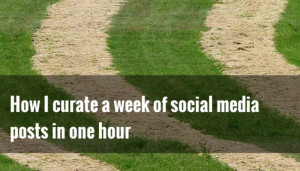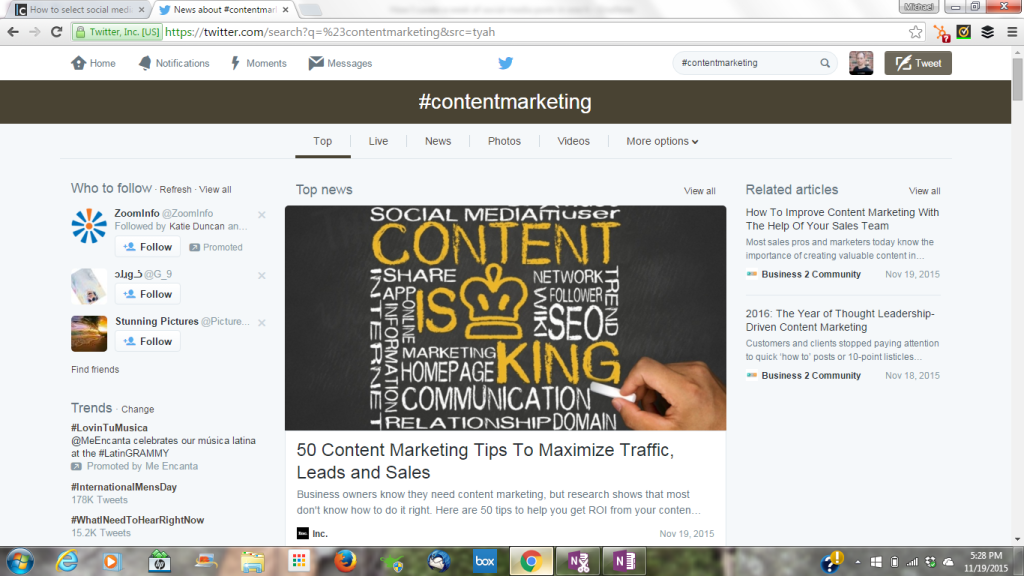 If you work in a small marketing department or you are a small business owner, finding time to maintain a presence on social media can seem like a daunting challenge.
If you work in a small marketing department or you are a small business owner, finding time to maintain a presence on social media can seem like a daunting challenge.
There are a so many platforms to choose from and so much content to sift through, it can be difficult to know where to start. And, without a clear strategy, social media results may seem nebulous at best.
Social Media Examiner’s seventh annual Social Media Marketing Industry Report, found that
most small businesses in their survey spend 6 hours per week or more on social media activities. That may seem like a lot of time. Depending on your focus and strategy, it may take that amount of time or longer to do it right. But, there are a some ways you can participate in social media without spending a ton of time and still get results.
I’ve worked with small businesses to get their social media off the ground with minimal ongoing time investment. I’m going to walk you through the specific steps I take to curate and schedule social media posts both for my organization and for me personally. But, before I do, there are two things you must do:
1. Find your platforms and set your goals
First, you need to identify the social media platforms that you should have a presence on and what you hope to accomplish on them. In a small business situation, you can’t spread yourself across too many platforms or you won’t be able to keep up.
If you’re not sure how to select the platforms that are right for your business, you may want to read this article for specific guidance before you proceed. Don’t listen to “experts” who tell you must be on a certain platform because that is where your customers are. Have them prove that or prove it to yourself before you dive headlong onto any social platform. It only take a couple of minutes to create an account. It takes much more time to maintain it properly over time.
That said, there are ways to leverage your posts across multiple platforms so you can have a wider presence without getting overwhelmed. I’ll get to that later in the article.
Finally, decide what you want to achieve on each platform and how you will measure your program. Are you seeking engagement with your posts, additional web traffic, social sharing? Document how you will measure success on each platform so you can determine if your social media marketing efforts are paying off.
2. Develop a content strategy
Once you have defined the platforms that are right for you and set your goals, you should consider the types of content that are valuable to your community.
Survey your own content and third party resources that align with their interests. Good third party sources include blogs, trade publications, twitter feeds, and LinkedIn Pulse stories to name a few. Continuously select content from a broad range of sources that relates to your marketplace and corresponds with your products or services on some level.
Your content should be informative and help your customers and prospects solve problems. Your focus is to become a trusted source of information and a valuable partner to them.
Now, you’re ready to begin curating and staging your content. Let’s get started.
RSS Feeds, Twitter, and Search Engines
Sharing content from multiple third-party sources is a great way to get going on social media quickly. But, visiting each source site every time you want to prepare social media posts will cost you a lot of time.
Enter RSS feeds.
RSS (Really Simple Syndication) allows you to aggregate and organize content from multiple online sources into a single channel. Essentially, you will be feeding content directly into one interface allowing you to quickly review articles of interest and select the ones you want to post.
At the office, I work on a desktop. Microsoft Outlook is my constant companion and it is able to accept RSS feeds directly. So, for aggregating content that I post for my employer, I use Outlook.

I have a separate Outlook folder setup for the feeds I like and, as new posts publish from those sources, the folder fills up. On Fridays, when I’m ready to stage my social media posts for the coming week, I expand the folder containing the RSS feeds and literally dozens of articles are available for me to choose from. They look just like email previews, so I can quickly scan headlines to select the articles that might be worth sharing and delete the ones that are not the right fit.
Adding a new RSS feed to Outlook is as simple as right clicking on the RSS folder and entering the URL of the feed which will usually look something like this: www.launchcatalyst.net/feed
To aggregate content that I post to my personal social media accounts, I use Feedly. Feedly is a great tool for organizing and discovering new content. I like Feedly because it has a very user-friendly iPad app so I can browse and stage content whether I’m sitting on the couch or on the go. Feedly connects directly with social media platforms like Facebook and Twitter so you can post directly to them or you can stage posts through apps like Buffer or utilize other iOS sharing options.

RSS feeds supply me with plenty of articles to choose from. However, I also like to look for content in sources that I may not capture regularly. Twitter is great for this purpose.
There are different strategies for discovering content on Twitter. Searching for a topic using a hashtag is an easy way to start. Hashtags in Twitter simply help to organize tweets relevant to a particular topic or conversation.
In the image below, you’ll see that I’ve searched the hashtag “#contentmarketing”. This search delivered tweets, images, and related articles that are great sources of content.
To track tweets from a particular set of sources, you’ll want to create a Twitter list. A list will let you look at tweets only from sources relevant to the list you created. For instance, I could create a list called “B2B Marketing” and select to include specific accounts that tweet about that topic. When I view the list, I’ll just see the latest tweets from resources I trust for B2B Marketing. For a quick guide on how to create lists in Twitter, visit their site.
If I’m just generally curious about top sources around a given topic, I’ll search Google. This is not the best way to aggregate content regularly, but it can help you uncover deep, authoritative content and locate new sources that you could potentially track through feeds or on Twitter. You could also setup Google alerts to get notified when something happens related to a keyword or phrase that’s important to you.
Scheduling content for social media
As I identify content that I want to share on social media, I immediately schedule it. At work, I use Hubspot for marketing automation. I have their Chrome extension installed so I can simply press a button in my browser and schedule a post on the fly.
To save time, I will usually stage the same tweet for release 2-3 times over the course of a week. It’s common knowledge that tweets don’t last a particularly long time, so tweeting the same content a few different times is not a problem as you won’t reach most of your audience at any given moment. I do make a concerted effort to change the wording in the tweets and experiment with new hashtags to make each tweet stand out.
LinkedIn is the other major platform we use at my organization, so while I’m creating the tweet, I’ll use the same Hubspot interface to create a LinkedIn post. Since we update our LinkedIn company page a little less frequently than Twitter, I try to be more selective about the articles I share there.
Remember, in addition to scheduling posts using third party content, you should share your own content as well. At work, when I’m using Hubspot, I can quickly review prior posts that had good engagement and select to repost them. I use this to help me recirculate my core content regularly. If you’re curious about how much of your own content you should be sharing in proportion to third party content, Buffer has a great post that can offer you additional guidance.
With this process, I can easily schedule enough content to fill our social media accounts for a week.
For my personal social media presence, I use Buffer. I generally discover content on Feedly and Twitter, then I use the Buffer app on my iPad to stage posts day-to-day directly from those applications.
Like Hubspot and most other social media scheduling programs, Buffer will allow you to post to multiple social media accounts. To make things easy, I schedule posts for Twitter and LinkedIn through Buffer. I have a Facebook page as well and that is setup to repost everything from my Twitter feed so I don’t have to post there separately. Buffer can also post directly to Facebook, but to avoid having posts go to my personal Facebook profile page, it was easier to connect Twitter to my Facebook company page directly.
That’s it. I spend about an hour each week to prepare social media posts for my company account and 15=20 minutes each night staging content for my personal accounts.
Beyond posting, social media works best when you’re, well, social. This means you’ll also want to devote time to commenting on posts, liking content, and exchanging messages when appropriate. If you carve out a few minutes a day for that activity, social media can enhance your business without putting a drain on your most precious resource, time.